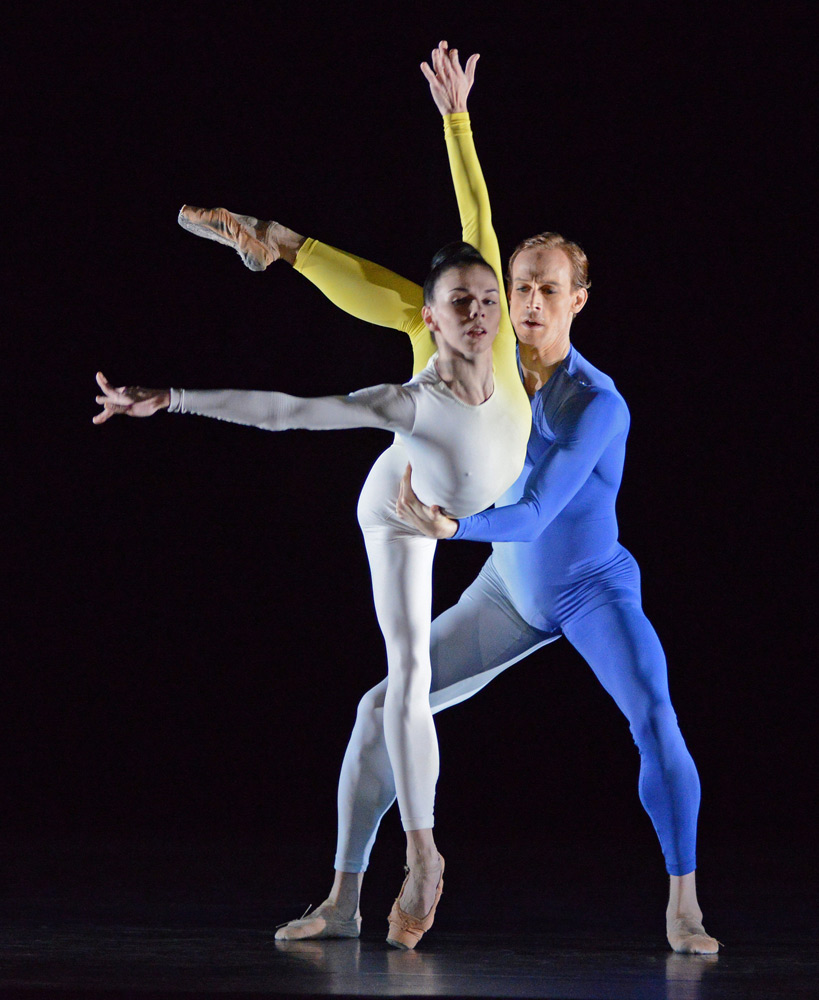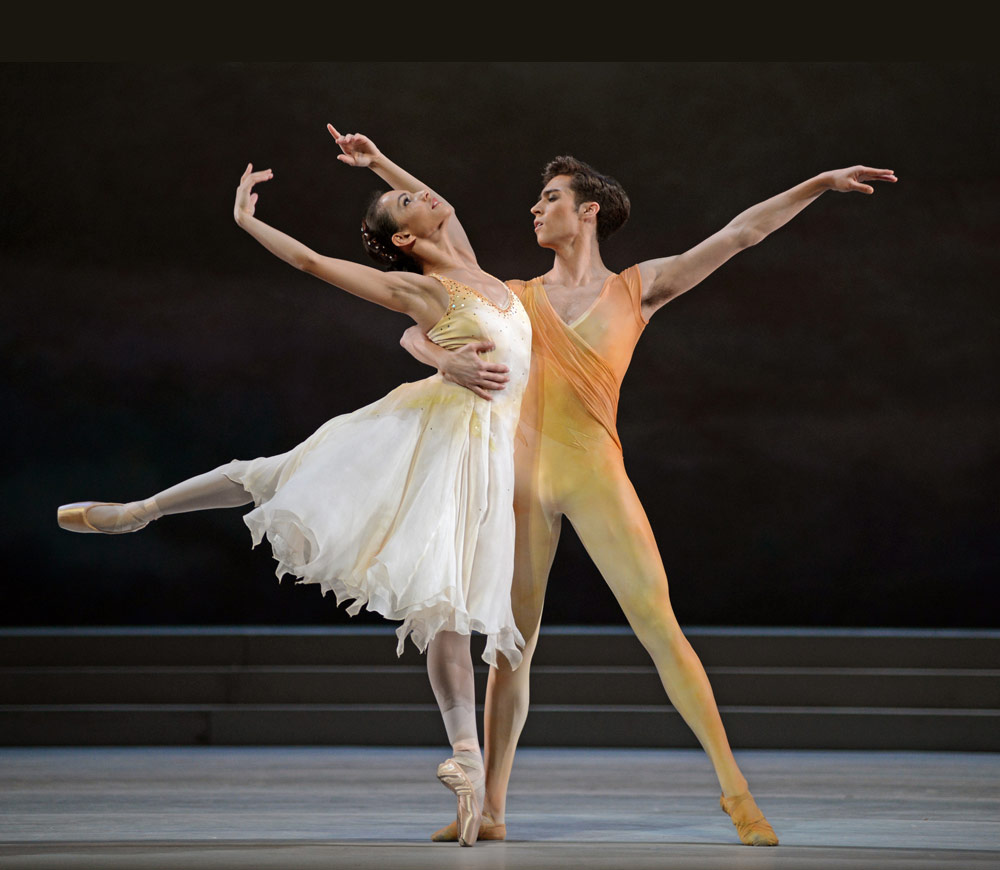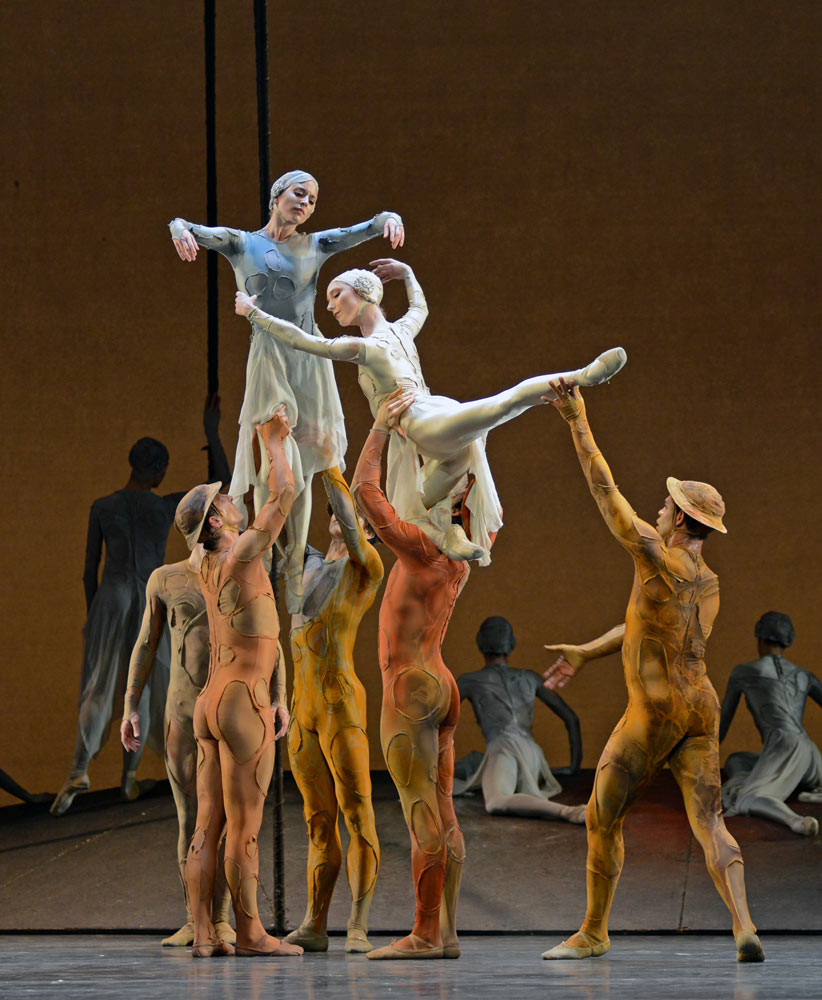
© ROH / Johan Persson 2014. (Click image for larger version)
Royal Ballet
Rhapsody, Tetractys -The Art of Fugue, Gloria
London, Royal Opera House
7 and 8 February 2014
Gallery of pictures by Dave Morgan
www.roh.org.uk
The Royal Ballet’s latest triple bill has a happy beginning and a sad ending and in the middle there’s Wayne McGregor’s new piece, Tetractys, an emotionally-neutral blank sheet on which you can write your own feelings – or more likely, your own thoughts.

© Dave Morgan, courtesy the Royal Opera House. (Click image for larger version)
Tetractys is set to seven sections of Bach’s Art of the Fugue, arranged and orchestrated by Michael Berkeley; the designs – coloured light sculptures – and the costumes are by Tauba Auerbach, and change to reflect the ‘geometry’ as well as the orchestral colouring of the music; and McGregor’s choreography takes off from the mathematics of the simple triangular arrangement which gives the ballet its name. That’s all you need to know, and I really wish that McGregor’s own explanations would one day stop at this level. According to Sarah Crompton’s programme note, he does know that ‘ultimately a work has to stand alone’, but it seems he can’t resist the urge to tell us at immensely detailed length about the creative process, so that his ballets arrive on stage weighed down by an intimidating load of philosophical, scientific or, in this case mathematical theorising which, far from helping, seriously distracts the attention from what’s actually happening in the moment

© Dave Morgan, courtesy the Royal Opera House. (Click image for larger version)
So I spent the first of the two performances I saw trying, with almost complete lack of success, to see in the ballet what McGregor said he had put there; the second time round I just watched, and found some at least of the things that his explanations hardly touch on – beauty, the occasional touch of humanity, humour even. You don’t need to understand the rationale for McGregor’s placing of duets, trios and larger ensembles to appreciate the wide variety of texture they provide and I particularly liked a pas de deux for Steven MacRae and Natalia Osipova, and enjoyed Sarah Lamb’s wit and sharpness in a trio with MacRae and Paul Kay too. In other sections McGregor’s invention ran out some time before Bach’s and there were passages which looked to me like the 21st century version of ‘vamp till ready’. The most serious problem, I thought, was that the piece always felt like a collection of unrelated items rather than an organic whole. But there was no faulting the dancers – mostly established McGregor favourites – who give everything they have to serve the choreography.(And yes, this was the performance where Osipova crashed into another dancer and concussed herself, and no, like almost everybody else, I didn’t notice.)

© Dave Morgan, courtesy the Royal Opera House. (Click image for larger version)
The happy start to the programme was Frederick Ashton’s Rhapsody, always welcome even in the current decor, inappropriate and unattractive. The constants in the two performances I saw were the corps de ballet, hardworking – especially the men – and packed with some of the company’s best young hopes, and the music, excitingly pushed on by Barry Wordsworth so that the central pas de deux had a tension I don’t remember feeling in it before. The leading roles, on the other hand, were about as different on the two days as it would be possible to imagine. First came Steven McRae and Laura Morera, who both danced in the last run, three years ago, though with different partners. I’d be amazed if I ever see Baryshnikov’s role better danced than by McRae, astonishingly clean, fast, every step perfectly executed; but I’m equally sure that I’ll see performances by less accomplished dancers that I will enjoy more. MacRae’s dancing glitters but for me it’s with a cold light and I’d love to see him find more charm in the piece and above all to make me think he’s enjoying the choreography rather than just doing it. Morera danced last time with Sergei Polunin and I think her sophisticated approach to Ashton was better matched with him than with MacRae. But she’s so fast, so bendy, so witty, just such a pleasure to watch – and surely there must be more roles in the repertoire that she could be illuminating like this.

© Dave Morgan, courtesy the Royal Opera House. (Click image for larger version)
Then the next day, after all this star power, we had James Hay and Francesca Hayward, both of them new to the ballet and indeed to big leading roles anywhere.

© Dave Morgan, courtesy the Royal Opera House. (Click image for larger version)
Of course it was a much quieter performance. Hay – just back from an injury – did remarkably well in choreography made for the great virtuoso of his time: his dancing was clear and true, sometimes evidently very near the edge of his capability but done with a simple integrity that was very appealing. He certainly deserves the chance to revisit the ballet in a year or two and make it his own. Hayward, though, already looks like the real thing and had a genuine triumph.. Those who attended the Ashton Symposium last September saw her very first try at this role, with its creator, Lesley Collier, teaching her just the basic steps of her big solo. After the first run through all Hayward could find breath to say was ‘It’s so hard!’ and it’s wonderful – and astonishing – to see her now making it look so easy and so natural. It was a gorgeous debut mixing present accomplishment with immense future promise. And an added bonus was that with this young pair in the leads the whole ballet reveals its beauty and – despite the tricksiness of Baryshnikov’s show-off steps – the simplicity at its heart and above all the unique bittersweet Ashton-ness that I find one of the most moving things in all ballet.

© Dave Morgan, courtesy the Royal Opera House. (Click image for larger version)
The sad bit at the end of the evening was Kenneth MacMillan’s Gloria, but for me the sadness came mainly not from the subject matter but from the performance. The first night seemed very flat and I thought that was perhaps due to the casting, but the second one – with Edward Watson in the leading role – wasn’t much stronger. I know that memory deceives us but surely this piece used to have a much sharper edge? It’s now done almost as an elegy – anguish and pain, yes, but where has the rage gone? I’ve always thought that the point of it was the fight between the sentiments of the music and the reality of death in the trenches and that seems to have disappeared completely – it diminishes the work and that‘s a real pity.

















I went into Tetractys feeling rather confused. I’d planned to do some light background reading in preparation for this performance. This reading turned out to be a lot more difficult that I expected… However, I think after thinking about it for a long, long time, it starts to make sense… I would like to contribute my blog entry to the debate: http://iheartballet.blogspot.co.uk/2014/02/tetractys-art-of-fuge.html